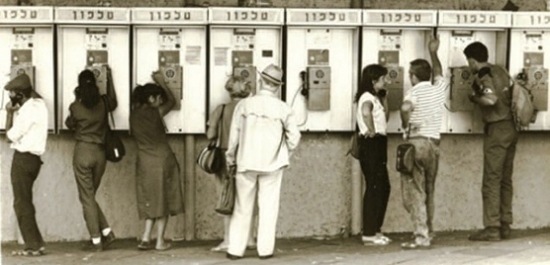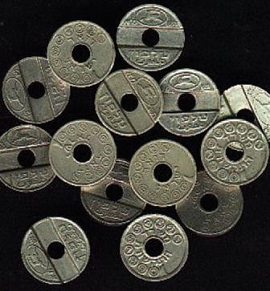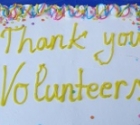
Ringing up the changes ... how people used to make telephone calls in Israel, from public call boxes in the street. Photo by Anat Saragusti
Unforgettable times! It was 1966 or so. I had just come to Israel from New York City and had managed to find a young woman with an apartment to share on Mapu Street in Tel Aviv. I alltooquickly discovered that communication with the outer world would be quite challenging for me.
When I first moved into this apartment I was informed by my flatmate-to-be that she had “invited” a telephone. Thus, still waiting andliving in a fifth floor walkupmade it necessary to descend all 90 stepsand walk a block to the nearest public phone every time a call was necessary or desired.
In addition to this, simple change was not acceptable food for the coin slot. Only telephone tokens would do. Do you remember these? They were made of metal and were small, round, and thick with a hole in the middle (in order to prevent mistaking them for money).
You had to go to the post office to buy these tokens.No one else sold them. The post office was a few blocks away and there always was a long line of people waiting. It wasn't always possible to stock up because the tokens were often rationed!
Finally, when suitably equipped,you were fully prepared to call.You
thoughtit would be easy. You went to the public phone, where a number of possibilities existed:
1. There was a queue and you would have to wait a few minutes.
2. The phone was out of order with a sign.
3. The phone was out of order without a sign, in which caseyou stood and put the token into the slot and it kept coming back or getting stuck inside.
4. Someone had pulled the phone out of its socket so that there was no receiver attached. It was just hanging, dangling in thin air, useless.
5. Someone was waiting for a call to come in. He was standing guard and refused to let anyone near the instrument.
6. The person just in front had a “trick”. He (it was always a male) had attached the token to a wire, put the token into the slot, still on the wire, made his call, removed the token after he had finishedhis conversation, and continued to call everyone he wanted for free via the token-on-the-wire. The wait was sometimes VERY long.When he finally left, you would approach, put the token in the slot and…
* There might be a busy signal, in which case, after three or four attempts, the next person in line got his chance
* No one answered at the other end, in which case you would perhaps wait until the next day to begin the routine again.Of course, in my case, trying to call again entailed climbing up those five flights of steps to the apartment so it was often easier to waitin a nearby coffee house or to walk up and down the streets.
* If the call was long distance and was answered, the phone would digest the tokens very rapidly and seemed to run out mid-conversation – sotheeasiest thing was to call collect.This sometimes took time and the people behind you often began to complain.
* You might, just might, be able to call with no problems.
There were usually a couple of other possibilities in the neighborhood.For example,you could use the often-to-be-found phones in the local grocery or kiosk. For a certain price, always substantially more than a public phone, anyone could make a local call. A call to another city would often be timed by a meter on the wall which seemed to jump every two seconds or so.The phone usually stood proudly on the counter so thateveryone there could hear everything you said! And wanted to!On the following morning, the grocer would ask you questions about your goings–on and you would be surprised that he knew so much…until you discovered the secret.

Telephone tokens ... you had to buy them at the post office
There was still another option, sometimes more private:visits. If you couldn't call, you could go.You could always drop in to see a neighbor with whom you had become friendly.
I had a neighbor like this. She wasHUGE. My 170" height reached her neck. Her girth was certainly twice her height. She rolled from room to room and down the street with her tiny, brown, short-tailed pincher. They were a steady pair. She was as friendly and hospitable as she was big. An added attraction was her being American. She lived two floors below us and had a phone which she allowed me to use in emergencies. So I could call home collect or receive an urgent call, but I still had to fend for myself in other situations.
If the neighbor wasn't at home, there were friends. You could walk or catch a bus, arrive at the destination and knock on a door or ring a bell and:“SURPRISE!Here I am.”Even if the chosen friend happened to be in pajamas, in shorts, cooking, waiting for invited guestsor ready to go out, a visitor, like you or me, could arrive. So he/she/they put on a most gracious smile and gave a "happy" shout of glee that you had appeared out of nowhere. You couldn't be leftstanding in the hallway, could you? So your friend(s)proceeded to invite you in.And you could deliver your phone call message inperson.

You could sit or even stayfor meals because it was, of course, rude on the part of the host to ask you to leave. If he/she happened to be on theway somewhere,you might be invited to come along (which often led to some interesting adventures like being taken to barmitzvahs or weddings of perfect strangers).Conversely, if the host really wanted an "out”, he/shecould CLAIM that there was a function to attend,walk you out, watch you depart, pretend to walk in the direction of the bus or sherut to go to the event,only to turn around after a few short minutes and returnhome when you were out of sight.
If nothing else worked and you had an urgent issue, you could send a telegram.Do you recall these? In those days, late 1960s, 1970s,1980s, you could take a bus to the main post office on Allenby Street. There, and only there could a letter couldbe sent that would arrive on the same day in Israel or abroad.You would hand-write a message, present it to the post office clerk in charge of telegrams, have him transliterate the message into Morse code and send it to the post office nearest to the recipient's destination where the message was deciphered. It was then typed onto strips of paper, after which the strips would be pasted onto another small sheet of usually yellow paper. This page would then be placed in a thinnish yellow envelope and delivered to the designated home after a few hours. The price was determined by the number of words and the distance. Day telegrams were costly. Night telegrams, called night letters, were a cheaper version because they arrived only on the following day.
As a means of communication, telegrams could be interesting.For example, way back when, I applied to teach at Bar Ilan University on a whim.I had not heard from them about receiving the position and also had not contacted them.The distance between my apartment and the university was three miles.
To my great surprise, about three weeks before the opening of the university,I began to receive barrages of telegrams from them to ascertain if I was planning to take the job or not even though I had had no notice of having been accepted. Of course, I finally made my descent to the phone. They said that they were so accustomed to having candidates call them incessantly that they hadn't even thought of contacting me before this.(I did begin teaching there a year later.)
Phoneless residences?Public phones, tokens only?Locallocales?Friends?Telegrams?
Yes, this is the way it really was!
 Table Top Mountain of Knitwear!
Table Top Mountain of Knitwear! Presents from the Children at After-School Purim Party
Presents from the Children at After-School Purim Party Little Asaf is Brought to Book!
Little Asaf is Brought to Book! A new website in English - on Volunteering - Launched in Israel
A new website in English - on Volunteering - Launched in Israel Help Needed for Abused Horses and Donkeys
Help Needed for Abused Horses and Donkeys Heather's Heseg
Heather's Heseg Deborah (Debby) Sherman
Deborah (Debby) Sherman